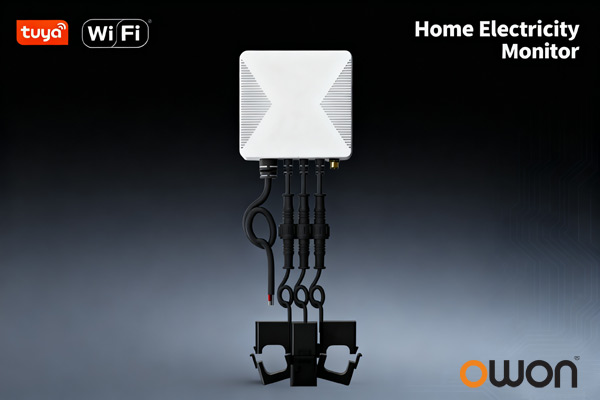As a long-standing manufacturer in the energy monitoring sector, OWON provides system integrators with the technical foundation needed to deploy reliable and scalable home energy monitoring solutions. This guide explores the key technologies, integration workflows, and best practices essential for modern residential energy meter applications.
1. Technology Overview of Home Energy Meters
Modern home energy meters go far beyond basic consumption recording. Today’s systems provide advanced functionality tailored to smart home and utility-grade applications.
✔ Real-time power quality monitoring
Including voltage, current, power factor, harmonics, and frequency data.
✔ Advanced data analytics
For identifying consumption patterns, detecting anomalies, and optimizing energy usage.
✔ Multi-protocol wireless communication
Supporting WiFi, Zigbee, LoRa / LoRaWAN, enabling flexible integration into home automation or utility platforms.
✔ Load identification (NILM)
Non-intrusive load monitoring for appliance-level insights.
2. Installation Best Practices for System Integrators
Proper installation directly impacts measurement accuracy and communication reliability.
✔ CT placement precision
Ensure correct orientation and tight coupling of current transformers to minimize measurement deviation.
✔ Signal integrity
Use noise-resistant cable routing, proper grounding, and shielding where required.
✔ Environmental considerations
Meters should operate within recommended temperature and humidity ranges.
✔ Calibration verification
Perform post-installation calibration checks to ensure Class 1 accuracy compliance.

3. Integration Strategies for Residential Energy Monitoring
Seamless system integration is critical for project success.
✔ Gateway and network configuration
Optimize signal strength and communication stability for WiFi, Zigbee, or LoRa deployments.
✔ Data management workflows
Implement structured data storage, edge filtering, and secure cloud transfer mechanisms.
✔ User interface (UI/UX) design
Provide intuitive dashboards for homeowners, utilities, or building managers.
✔ API and platform interoperability
Support third-party platforms through open APIs, MQTT, RESTful integration, or Modbus TCP.
4. Key Technical Specifications to Evaluate
When selecting smart home energy meters, consider the following parameters:
✔ Measurement Accuracy
Class 1 or better for dependable real-world performance.
✔ Sampling Rate
A higher sampling frequency provides more detailed load analysis and event detection.
✔ Communication Reliability
Stable wireless performance in high-interference residential environments.
✔ Power Consumption
Low-power design for continuous, long-term operation.
5. OWON’s Technical Solutions
OWON’s energy monitoring ecosystem is engineered for B2B project scalability and reliability.
✔ Modular architecture
Flexible deployment across single-phase, multi-phase, or distributed energy systems.
✔ Open-standards compliance
Smooth integration with Home Assistant, Zigbee gateways, WiFi cloud apps, and LoRaWAN networks.
✔ Cybersecurity and data protection
AES encryption, secure firmware, and strict data privacy protocols.
✔ Quality manufacturing
Industrial-grade components and strict testing guarantee durable field performance.
6. Advanced Applications of Home Energy Meters
Modern monitoring systems support a wide range of value-added use cases:
✔ Demand response and load shifting
Enable participation in utility smart grid programs.
✔ Solar PV integration
Monitor production, consumption, net metering, and battery storage behavior.
✔ EV charging optimization
Coordinate home EV chargers for load balancing and cost savings.
✔ Time-of-use (TOU) optimization
Help consumers adapt consumption patterns based on dynamic electricity pricing.
7. Recommended Implementation Methodology
Successful energy monitoring projects follow a structured workflow:
✔ Site assessment
Evaluate wiring layouts, gateway placement, and communication environments.
✔ System design
Select appropriate meter models, protocols, and CT sizes.
✔ Testing procedures
Conduct signaling, accuracy, and interoperability tests before commissioning.
✔ Documentation
Provide clear wiring diagrams, communication architecture, and maintenance guides.
8. Maintenance and Long-Term Support
Reliable operation requires ongoing maintenance and monitoring.
✔ Remote diagnostics
Real-time fault detection and health monitoring.
✔ Firmware lifecycle management
Routine firmware updates addressing security, performance, and compatibility.
✔ Performance tracking
Monitor system health and long-term trends for continuous improvement.
✔ Professional technical support
Access to expert assistance for integration or field issues.
Conclusion
Home energy meters represent a critical component in modern residential energy ecosystems. For system integrators, proper selection, installation, and integration of these meters greatly improve system stability, data accuracy, and customer satisfaction. With proven expertise and open-protocol smart meter solutions, OWON supports integrators in delivering high-performance, future-ready energy monitoring installations.